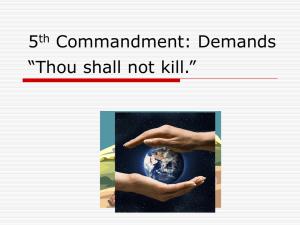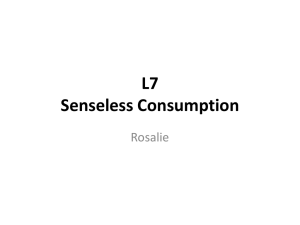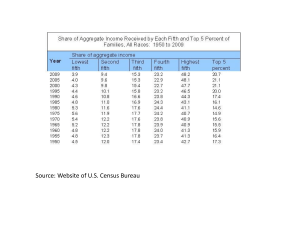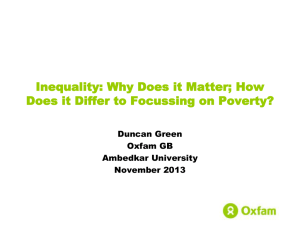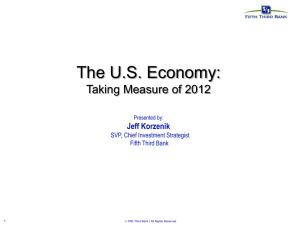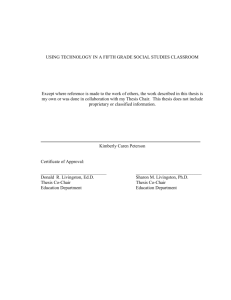The Rise and Consequences of Inequality Alan B. Krueger
advertisement
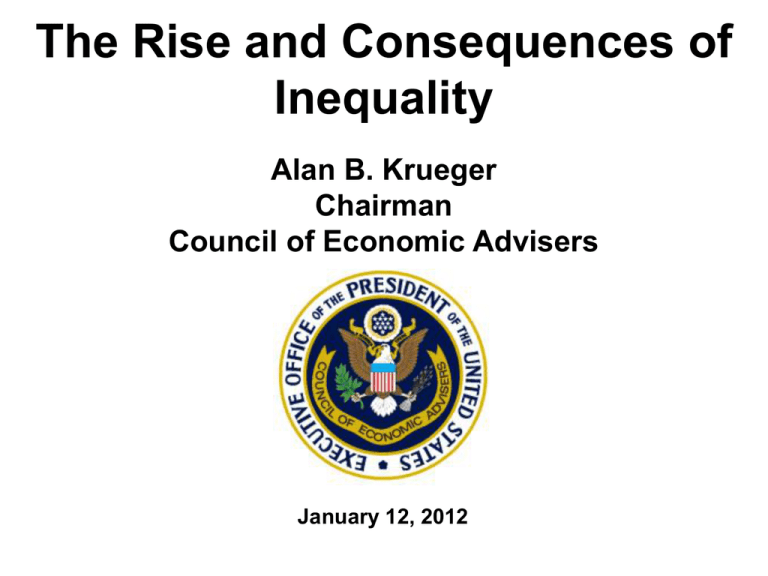
The Rise and Consequences of Inequality Alan B. Krueger Chairman Council of Economic Advisers January 12, 2012 Figure 1: Growing Together, Growing Apart Income Growth by Quintile, Various Periods Annual Growth Rate of Real Income Across the Family Income Distribution 1947 to 1979 Annual Growth Rate of Real Income Across the Family Income Distribution 1979 to 2010 Percent 3.5% Percent 3.5% 3.0% 3.0% 2.5% 2.4% 2.5% 2.4% 2.2% 2.5% 2.2% 2.0% 2.0% 1.5% 1.5% 1.2% 1.0% 1.0% 0.6% 0.5% 0.5% 0.3% 0.1% 0.0% 0.0% Lowest fifth 2nd fifth Mid fifth 4th fifth Top fifth -0.5% -0.4% Lowest fifth 2nd fifth Mid fifth 4th fifth Top fifth Source: Census Bureau January 12, 2012 1 Figure 2: Growing Together Again 1992-2000 Annual Growth Rate of Real Income Across the Family Income Distribution 1992-2000 Percent 4.0% 3.5% 3.5% 3.0% 2.6% 2.5% 2.0% 2.0% 1.9% 1.8% 2nd fifth Mid fifth 1.5% 1.0% 0.5% 0.0% Lowest fifth 4th fifth Top fifth Source: Census Bureau January 12, 2012 2 Figure 3: If Real Incomes Had Grown During the 2000s as They Did During the 1990s, the Median Household Would Have an Extra $8,900 in Annual Income in 2010 Median Household Income 2010 Dollars 60,000 58,000 56,000 If median household income had grown during the 2000s at the same rate as it did during the 1990s 54,000 $8,900 52,000 50,000 2010 48,000 Actual 46,000 44,000 42,000 79 81 83 85 87 89 91 93 95 97 99 01 03 05 07 09 Note: Shading denotes recession. Source: Census Bureau; CEA calculations January 12, 2012 3 Figure 4: CBO Estimates Show Much Faster Income Growth for the Top 1% Growth in Real After-Tax Income, 1979-2007 Percent Change 300% 278% 250% 200% 150% 100% 65% 50% 18% 28% 35% 43% 0% Lowest Quintile Second Quintile Middle Quintile Fourth Quintile 81st-99th Percentiles Top 1 Percent Source: CBO January 12, 2012 4 Figure 5: Income Inequality Near Record High Share of Income Earned,1916-2009 Percent of All U.S. Income 25 20 15 Top 1% 10 Top 0.1% 5 0 1916 1926 1936 1946 1956 1966 1976 1986 1996 2006 Source: 2010 update to Piketty and Saez (2006) January 12, 2012 5 Figure 6: The Size of the Middle-Class has Fallen Percent of Households With Annual Income Within 50% of the Median Percent 52 50.3 50 48 47.3 45.6 46 44.2 44 42.2 42 40 0 38 1970 1980 1990 2000 2010 Source: CEA Calculations from Current Population Survey January 12, 2012 6 Figure 7: “The Great Gatsby Curve” Higher income inequality associated with lower intergenerational mobility The . Great Gatsby Curve Intergenerational earnings elasticity 0.6 0.6 0.5 0.5 United Kingdom United States France 0.4 0.4 Japan Germany 0.3 New Zealand Sweden 0.2 y = 2.2x - 0.27 R² = 0.76 Finland y = 2.2x - 0.27 R² = 0.76 Norway 0.3 0.2 Denmark 0.1 0.15 0.20 0.25 0.30 0.35 0.1 0.40 Inequality (1985 Gini Coefficient) Source: Corak (2011), OECD, CEA estimates January 12, 2012 7 Figure 8: “The Great Gatsby Curve”: Projection The . Great Gatsby Curve Intergenerational earnings elasticity 0.6 0.6 United States United States (2010) (2010 Gini) 0.5 0.5 United Kingdom United States France 0.4 0.4 Japan Germany 0.3 New Zealand Sweden 0.2 0.3 y = 2.2x - 0.27 R² = 0.76 0.2 Finland Norway y = 2.2x - 0.27 R² = 0.76 Denmark 0.1 0.15 0.20 0.25 0.30 0.35 0.1 0.40 Inequality (1985 Gini Coefficient) Source: Corak (2011), OECD, CEA estimates January 12, 2012 8 Figure 9: Causes of Higher Inequality Box-5-3.─The Expert's Consensus on Earnings Inequality Average percent distribution 50 40 30 20 10 0 Technological change Other and unknown International trade Decline in real minimum wage Decline in unionization Rising Immigration Source: Economic Report of the President, 1997 January 12, 2012 9 Figure 10: U.S. Tax Code is Less Progressive than Most Other OECD Countries Gini Coefficient Before and After Taxes and Transfers, 2010 0.6 Before tax After tax 0.5 0.4 0.3 0.2 0.1 0 Source: OECD January 12, 2012 10 Figure 11: Despite large tax cuts, less dynamism Startup Employment as a Share of Total Employment Percent 3.5 OBRA Deficit Reduction Act Balanced Budget Act JGTRRA EGTRRA 3.3 3.0 Average: 1993-2000 2.8 Average: 2001-2007 2.5 1990 1992 1994 1996 1998 2000 2002 2004 2006 2008 Source: Business Dynamics Statistics January 12, 2012 11 Consequences • Intergenerational Mobility • Consumption • Aggregate demand and excess leverage. • Economic Growth • Morale and Productivity January 12, 2012 12 The Rise and Consequences of Inequality Alan B. Krueger Chairman Council of Economic Advisers January 12, 2012

